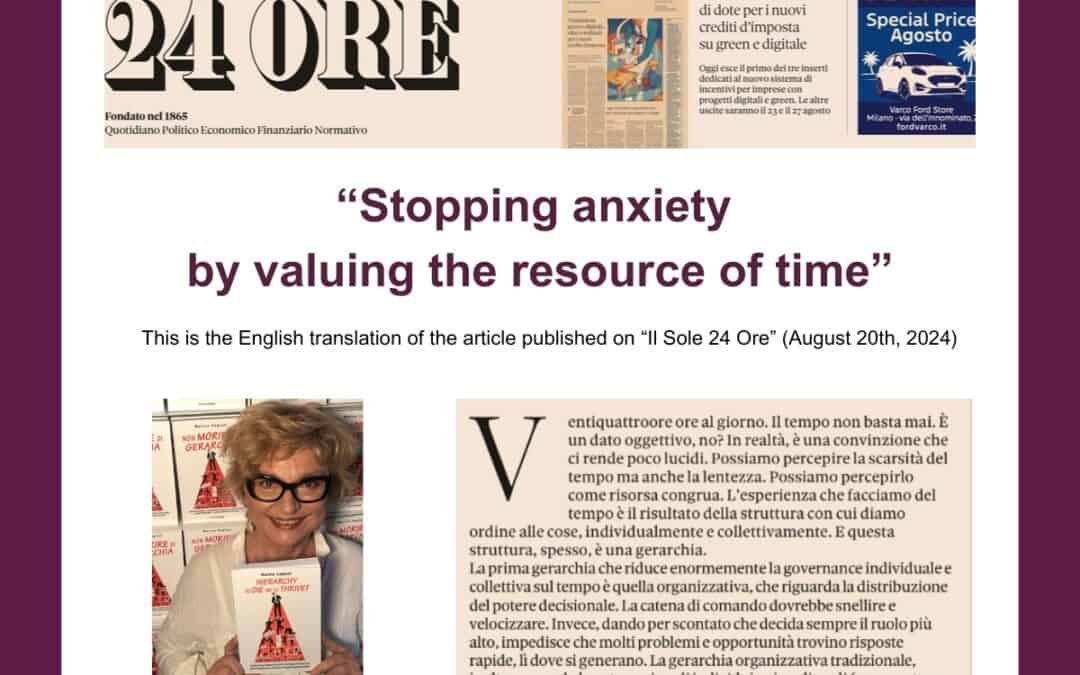by Marina Capizzi
Twenty-four hours a day. Time is never enough. That’s a fact of life, isn’t it? Actually, it is a belief that makes us lackluster. We can perceive the scarcity of time but also the slowness. We can perceive it as a congruent resource. Our experience of time is the result of the structure by which we give order to things, individually and collectively. And this structure, often, is a hierarchy.
The first hierarchy that greatly reduces individual and collective governance over time is the organizational hierarchy, which concerns the distribution of decision-making power. Chain of command should slim down and speed up. Instead, by assuming that the highest role always decides, it prevents many problems and opportunities from finding quick answers, there where they are generated. The traditional organizational hierarchy, moreover, being based on individuals and individual roles (and not on teams with common goals), takes a great deal of time to put back together what is originally separate (information, activities, skills).
How? By having many, long, inconclusive meetings where we face powerful (usually implicit) hierarchies that eat up our time: hierarchies of trust, hierarchies of values, hierarchies of priorities. And we could go on. Getting out of them is really difficult. So? Is there a hierarchy that can help us put order in this wilderness?
Yes, there is. It is a hierarchy we deal with every moment of our lives because it is the backbone of our Autonomic Nervous System (ANS), which, as Stephen Porges, American neuroscientist and father of the Polyvagal Theory, has shown, is a product of evolution. The ANS works like a h24 radar to identify danger and safety signals that come from our body, context, and interaction with others. This biological hierarchy has a lot to do with time governance because it works with a brake and an accelerator, activated according to the perceived level of danger/safety. It all happens outside our awareness but we can recognize the effects.
Do we start running, fail to stop to think, stop listening, lose the big picture? It is because our biological hierarchy pushes on the accelerator putting rushing on top.
Time shrinks, it is never enough, we become hostages to the impulse to act. “For when is this work needed?” “For yesterday.” Companies call it “sense of urgency” and believe it generates speed. But the more we accelerate, the less time we have. Those in management roles increase command and control by feeding the “chain of anxiety.” There is no time to talk to each other, to understand: without listening and understanding we become frenetic, conflictive and inconclusive.
We come home late, tired and frustrated.
And when it all becomes too much, the biological hierarchy hits the brakes. The energy runs out. We lose interest, motivation, we lock ourselves in our shell. Time becomes empty, meaningless. At the top of the biological hierarchy goes immobility: doing the bare minimum, procrastinating, not interacting, not responding. It is the hierarchy of quiet quitting and burnout.
We as humans, however, have the ability to use both the accelerator and the brake by adjusting speed and renewing energy. When this happens, time no longer obsesses us. Are you familiar with soft skills? In this state they come naturally to us: we become essential, we listen, we think together with others, we share skills, we feel we belong to larger systems… That’s why we achieve the best effort/outcome ratio.
Magic? No. It happens when our biological hierarchy puts connection with ourselves, others, and context at the top. The switch?
A mutual safety experience, if only for a few moments, that puts us in the perspective of creating safety together. The shared experience of safety activates the hierarchy of connection; connection fuels safety. Thus, we become masters of our time. When we instead seek safety by defending ourselves from others, we become hostages to rush or immobility. Hierarchies of connection hand us the governance of time; hierarchies of defense deprive us of it.
There is a very close connection between biological hierarchy and the other hierarchies we as humans produce. When I applied Porges’ studies, developed in neurology, to human social systems, a previously unseen view of observation, understanding and intervention in organizations opened up. And it was precisely the use of time that appeared as a link between biological hierarchy and organizational hierarchy: life and time in our bodies, life and time in the social body.
Author of Hierarchy to Die or to Thrive?
